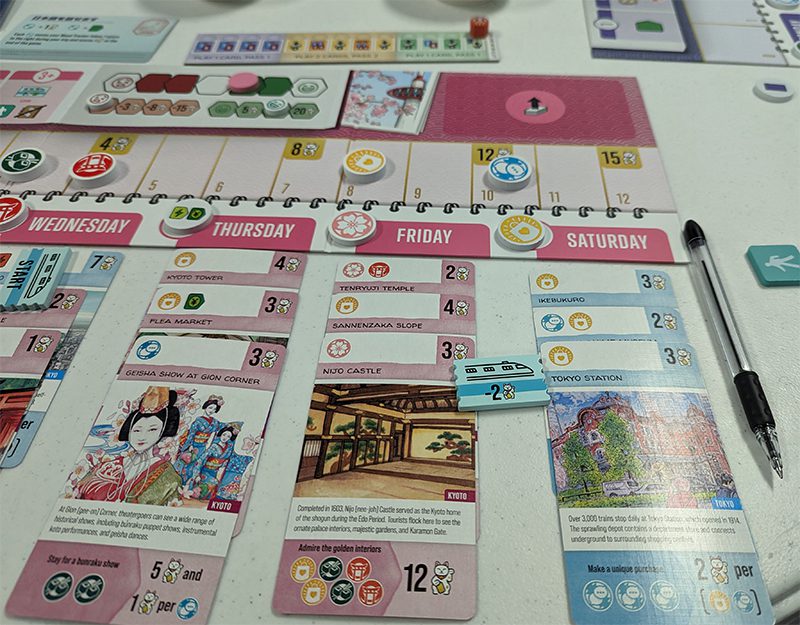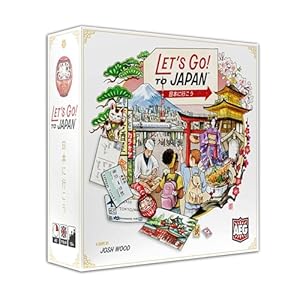Disclosure: Meeple Mountain received a free copy of this product in exchange for an honest, unbiased review. This review is not intended to be an endorsement.
Japan, a nation that has seamlessly woven itself into the fabric of our daily lives, defies the need for introduction. From the vehicles we navigate our streets with, to the gaming platforms that transport us to realms of fantasy, and the captivating animations that grace our screens, Japan’s influence is something we cannot ignore. Yet, its significance extends far beyond media manifestations and cars. Even its long, rich history has lured the eyes of Hollywood as it tries to capture its historical grandeur on the silver screen.
Encapsulating the essence of Japan’s vast cultural tapestry is a daunting task, and it’s the perfect backdrop for a game about vacation planning. Let’s Go To Japan is a game that focuses on the dilemma of every traveler longing to immerse themselves in Japanese culture. In this game, you are thrust into a crucible of decision-making, forced to prioritize and curate your journey with watchmaker precision. The objective? Craft a vacation plan that eclipses the experiences of your peers.
Vacation Planning Enigma
The game tries to facilitate this conundrum through card drafting. For those unfamiliar with the term, card drafting is where you get a hand of cards, pick one card to play, and pass the rest to a neighboring player. Unlike most card drafting games like 7 Wonders and Sushi Go, your options here are quite limited. Most games give you a healthy number of cards in your hand, allowing you to measure your options. In Let’s Go To Japan, two-thirds of the game only gives you the option to pick one card out of two. Lack of information is one of the many challenges this game offers.
Another challenge is the use of train tickets. The deck of cards, representing the various activities in Japan, is split between the Tokyo and Kyoto decks. Each time you do an activity that requires you to travel to another region, you need to buy a train ticket. Your first one is free, but future train tickets will force you to take a negative two point penalty, so you have to be very thorough with your planning.
Planning is as simple as picking a card from your hand and “playing” it on one of the six days of the week. A day can have a stack of three cards and once it is full, it is locked in for the rest of the game. What’s interesting here is that when you play cards, nothing moves. You move all the tracks and do the scoring at the end of the game, starting from the beginning of the week and moving forward.

Expensive Pleasure
As for the cards themselves, all of them will give you points while giving you experience icons and adjusting your mood. Experience icons are just a thematic way of using colored icons for set collection purposes. Is your activity related to food? Chances are it will have the green food icon experience on it and the further down the track you go, the more points you score.
The mood is another part you have to be concerned about, as expensive or exhausting activities will decrease your mood, while cheap or relaxing activities will improve it. The mood, much like the experience track, will impact your scoring.
To make planning a bigger challenge, every last card of the day has a “highlight” scoring opportunity. If you happen to hit the requirement while scoring at the end of the game, you get more points. I love this feature as it greatly impacts your decision making on previous days while allowing players to curate their own scoring possibilities.
One of the most enjoyable aspects of the game is the “go for a walk” mechanic. If you’re not satisfied with the cards in your hand, you have the option to discard one and draw a new card from one of the two decks. However, there’s a twist—you don’t get to see the other side of the drawn card until the end of the game. This means you won’t know the actual activity until later, adding an element of uncertainty. Despite its simplicity, this mechanic beautifully incorporates narrative sensibility, while providing players with an excellent decision-making opportunity.
It’s Friday In California
An important facet to keep in mind is that each day has a designated favorable experience type, determined during the game’s setup. After completing a day by placing three cards, you receive bonuses based on how well the experiences on those cards align with the day’s favored experience. These bonuses can take various forms, such as an immediate mood boost, earning wild experience tokens for later use, or obtaining a luxury train ticket that awards points instead of deducting them.
It would be complete misinformation if I stated that card drafting games aren’t oversaturated. Card drafting is a busy genre and any game trying to get its foot through that reinforced steel door will have trouble. Fortunately for Let’s Go To Japan, this isn’t the case.
While one could take a surface-level approach and praise the game’s visually stunning artwork, which evokes the aesthetic of Japanese tourism propaganda with its small factoids listed on each card, there is more depth to explore. Beyond the captivating visuals, the game’s true beauty lies in its simplicity. Unlike many other games that can be bogged down by complexity, this one boasts a streamlined set of rules that are easy to grasp, allowing players to dive into the experience with little friction.
Well, almost. The game’s uniqueness comes from playing your cards on an open calendar. At first, it might appear daunting since the start of the game is a blank white sheet for you. Much like a middle-aged bored Japanese housewife discovering Yaoi for the first time, the options are overwhelming, especially since players aren’t getting instant feedback on their decisions.

First Impressions May Vary
Unfortunately, this did lead to some sessions where confusion and misplay overtook pleasure. Playing the game isn’t that hard, but understanding the mechanisms of scoring can feel quite off putting, especially since you see all the moving parts only at the end of the game. Now, this would be a major problem if this were a 3 hour marathon, but it isn’t. The game lasts about 30 to 45 minutes, so this hurdle of confusion is hardly a major commitment.
And it is a hurdle worth leaping over because this is a solid, lightweight drafting game. Let’s Go To Japan isn’t meant to hurt your brain; instead, it wants you to stimulate and engage with it. The first half of the game gives you a sense of freedom to place your activities where you see fit. When the latter half presents itself, there is an increasingly challenging dynamic. As more days become locked, the windows of opportunity gradually close, limiting the available options for placing activities. It’s not a complex puzzle, but it is an interesting one.
If anything, I wish the puzzle was more captivating. One area I will point out is the isolated nature of the experience. Hate drafting, the act of denying other players’ cards they need, is hardly a productive move since players can simply “go for a walk” if their hand is bad. This is the type of game where players’ eyes are squarely focused on the board and cards in front of them, only lifting their heads to see each other at the end of the game for scoring.
It also surrenders itself to the typical tropes of drafting games, mainly set collection. Once the honeymoon phase is worn down and the shiny chrome dulls, it is simply a game about collecting colored icons. Sure, you will get a few laughs about the activities being planned, such as spending the entire day eating or slowly destroying your body by doing back-to-back drumming lessons, but those feelings become mute as you play more. While the “highlight” mechanism tries to subvert expectations, it doesn’t take too long to master it. I recall one five player game session where three of us were tied, suggesting this isn’t a highly skill-based game.
This isn’t to say that Let’s Go To Japan is a bad game. Compared to many other “vibing in Japan” games that I’ve experienced, like Tokaido, I find this one to be better than most, and the unique vacation planning system is something worth applauding. While initial confusion from delayed scoring feedback may arise, the game’s relatively short playtime ensures this hurdle is minor. Despite the lack of direct interaction and the abundance of set collection mechanics, one cannot deny the visually stunning representation of Japanese culture. Much like the culture of Japan, it is a game worth experiencing more than once.












Add Comment